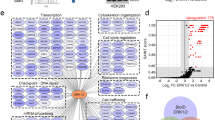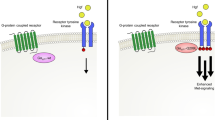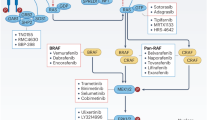Abstract
Cutaneous malignant melanoma is considered one of the most deadly human cancers, based on both its penchant for metastatic spread and its typical resistance to currently available therapy. Long known to harbor oncogenic NRAS mutations, melanomas were more recently reported to be frequent bearers of activating mutations in BRAF, one of the effectors situated downstream of wild-type NRAS. NRAS and BRAF mutations are rarely found in the same melanoma, suggesting that they may possess important overlapping oncogenic activities. Here, we compare and contrast the oncogenic roles of the three major NRas downstream effectors, Raf, phosphatidylinositol 3-kinase (PI3K) and Ral guanine exchange factor (RalGEF), using genetically engineered Arf-deficient immortalized mouse melanocytes as a model system. Although no single downstream pathway could recapitulate all of the consequences of oncogenic NRas expression, our data indicate a prominent role for BRaf and PI3K in melanocyte senescence and invasiveness, respectively. More surprisingly, we discovered that constitutive RalGEF activation had a major impact on several malignant phenotypes, particularly anchorage-independent growth, indicating that this often overlooked pathway should be more carefully evaluated as a possible therapeutic target.
This is a preview of subscription content, access via your institution
Access options
Subscribe to this journal
Receive 50 print issues and online access
$259.00 per year
only $5.18 per issue
Buy this article
- Purchase on Springer Link
- Instant access to full article PDF
Prices may be subject to local taxes which are calculated during checkout




Similar content being viewed by others
References
Albini A, Iwamoto Y, Kleinman HK, Martin GR, Aaronson SA, Kozlowski JM et al. (1987). A rapid in vitro assay for quantitating the invasive potential of tumor cells. Cancer Res 47: 3239–3245.
Bennett DC . (2008). How to make a melanoma: what do we know of the primary clonal events? Pig Cell Melan Res 21: 27–38.
Bodemann BO, White MA . (2008). Ral GTPases and cancer: linchpin support of the tumorigenic platform. Nat Rev 8: 133–140.
Brose MS, Volpe P, Feldman M, Kumar M, Rishi I, Gerrero R et al. (2002). BRAF and RAS mutations in human lung cancer and melanoma. Cancer Res 62: 6997–7000.
Chien Y, Kim S, Bumeister R, Loo YM, Kwon SW, Johnson CL et al. (2006). RalB GTPase-mediated activation of the IkappaB family kinase TBK1 couples innate immune signaling to tumor cell survival. Cell 127: 157–170.
Chien Y, White MA . (2003). RAL GTPases are linchpin modulators of human tumour-cell proliferation and survival. EMBO Rep 4: 800–806.
Chin L, Garraway LA, Fisher DE . (2006). Malignant melanoma: genetics and therapeutics in the genomic era. Genes Dev 20: 2149–2182.
Chudnovsky Y, Adams AE, Robbins PB, Lin Q, Khavari PA . (2005). Use of human tissue to assess the oncogenic activity of melanoma-associated mutations. Nat Genet 37: 745–749.
Curtin JA, Fridlyand J, Kageshita T, Patel HN, Busam KJ, Kutzner H et al. (2005). Distinct sets of genetic alterations in melanoma. New Engl J Med 353: 2135–2147.
Dahl C, Guldberg P . (2007). The genome and epigenome of malignant melanoma. APMIS 115: 1161–1176.
Dankort D, Curley DP, Cartlidge RA, Nelson B, Karnezis AN, Damsky Jr WE et al. (2009). Braf(V600E) cooperates with Pten loss to induce metastatic melanoma. Nat Genet 41: 544–552.
Davies H, Bignell GR, Cox C, Stephens P, Edkins S, Clegg S et al. (2002). Mutations of the BRAF gene in human cancer. Nature 417: 949–954.
de Gorter DJ, Reijmers RM, Beuling EA, Naber HP, Kuil A, Kersten MJ et al. (2008). The small GTPase Ral mediates SDF-1-induced migration of B cells and multiple myeloma cells. Blood 111: 3364–3372.
Downward J . (2003). Targeting RAS signalling pathways in cancer therapy. Nat Rev 3: 11–22.
Dumaz N, Hayward R, Martin J, Ogilvie L, Hedley D, Curtin JA et al. (2006). In melanoma, RAS mutations are accompanied by switching signaling from BRAF to CRAF and disrupted cyclic AMP signaling. Cancer Res 66: 9483–9491.
Falsetti SC, Wang DA, Peng H, Carrico D, Cox AD, Der CJ et al. (2007). Geranylgeranyltransferase I inhibitors target RalB to inhibit anchorage-dependent growth and induce apoptosis and RalA to inhibit anchorage-independent growth. Mol Cell Biol 27: 8003–8014.
Feig LA . (2003). Ral-GTPases: approaching their 15 minutes of fame. Trends Cell Biol 13: 419–425.
Freedberg DE, Rigas SH, Russak J, Gai W, Kaplow M, Osman I et al. (2008). Frequent p16-independent inactivation of p14ARF in human melanoma. J Natl Cancer Inst 100: 784–795.
Goel VK, Lazar AJ, Warneke CL, Redston MS, Haluska FG . (2006). Examination of mutations in BRAF, NRAS, and PTEN in primary cutaneous melanoma. J Invest Derm 126: 154–160.
Gray-Schopfer V, Wellbrock C, Marais R . (2007). Melanoma biology and new targeted therapy. Nature 445: 851–857.
Ha L, Ichikawa T, Anver M, Dickins R, Lowe S, Sharpless NE et al. (2007). ARF functions as a melanoma tumor suppressor by inducing p53-independent senescence. Proc Natl Acad Sci USA 104: 10968–10973.
Hamad NM, Elconin JH, Karnoub AE, Bai W, Rich JN, Abraham RT et al. (2002). Distinct requirements for Ras oncogenesis in human versus mouse cells. Genes Dev 16: 2045–2057.
Heidecker G, Huleihel M, Cleveland JL, Kolch W, Beck TW, Lloyd P et al. (1990). Mutational activation of c-raf-1 and definition of the minimal transforming sequence. Mol Cell Biol 10: 2503–2512.
Lim KH, Baines AT, Fiordalisi JJ, Shipitsin M, Feig LA, Cox AD et al. (2005). Activation of RalA is critical for Ras-induced tumorigenesis of human cells. Cancer Cell 7: 533–545.
Lim KH, O'Hayer K, Adam SJ, Kendall SD, Campbell PM, Der CJ et al. (2006). Divergent roles for RalA and RalB in malignant growth of human pancreatic carcinoma cells. Curr Biol 16: 2385–2394.
Michaloglou C, Vredeveld LC, Soengas MS, Denoyelle C, Kuilman T, van der Horst CM et al. (2005). BRAFE600-associated senescence-like cell cycle arrest of human naevi. Nature 436: 720–724.
Omholt K, Hansson J . (2007). No evidence of RALGDS mutations in cutaneous melanoma. Melan Res 17: 410–412.
Oxford G, Owens CR, Titus BJ, Foreman TL, Herlevsen MC, Smith SC et al. (2005). RalA and RalB: antagonistic relatives in cancer cell migration. Cancer Res 65: 7111–7120.
Pollock PM, Harper UL, Hansen KS, Yudt LM, Stark M, Robbins CM et al. (2003). High frequency of BRAF mutations in nevi. Nat Genet 33: 19–20.
Pollock PM, Meltzer PS . (2002). A genome-based strategy uncovers frequent BRAF mutations in melanoma. Cancer Cell 2: 5–7.
Rangarajan A, Hong SJ, Gifford A, Weinberg RA . (2004). Species- and cell type-specific requirements for cellular transformation. Cancer Cell 6: 171–183.
Recio JA, Noonan FP, Takayama H, Anver MR, Duray P, Rush WL et al. (2002). Ink4a/arf deficiency promotes ultraviolet radiation-induced melanomagenesis. Cancer Res 62: 6724–6730.
Rosse C, Hatzoglou A, Parrini MC, White MA, Chavrier P, Camonis J . (2006). RalB mobilizes the exocyst to drive cell migration. Mol Cell Biol 26: 727–734.
Smith SC, Oxford G, Baras AS, Owens C, Havaleshko D, Brautigan DL et al. (2007). Expression of ral GTPases, their effectors, and activators in human bladder cancer. Clin Cancer Res 13: 3803–3813.
Stiles BL . (2009). Phosphatase and tensin homologue deleted on chromosome 10: extending its PTENtacles. Internatl J Biochem Cell Biol 41: 757–761.
Tsao H, Zhang X, Benoit E, Haluska FG . (1998). Identification of PTEN/MMAC1 alterations in uncultured melanomas and melanoma cell lines. Oncogene 16: 3397–3402.
Urano T, Emkey R, Feig LA . (1996). Ral-GTPases mediate a distinct downstream signaling pathway from Ras that facilitates cellular transformation. EMBO J 15: 810–816.
Virador VM, Kobayashi N, Matsunaga J, Hearing VJ . (1999). A standardized protocol for assessing regulators of pigmentation. Anal Biochem 270: 207–219.
Wellbrock C, Ogilvie L, Hedley D, Karasarides M, Martin J, Niculescu-Duvaz D et al. (2004). V599EB-RAF is an oncogene in melanocytes. Cancer Res 64: 2338–2342.
Wu H, Goel V, Haluska FG . (2003). PTEN signaling pathways in melanoma. Oncogene 22: 3113–3122.
Yin J, Pollock C, Tracy K, Chock M, Martin P, Oberst M et al. (2007). Activation of the RalGEF/Ral pathway promotes prostate cancer metastasis to bone. Mol Cell Biol 27: 7538–7550.
Acknowledgements
We thank Dr Christopher Counter (Duke University) for useful discussions, and for communicating data before publication. We acknowledge Dr Paul Khavari (Stanford University) for gifting the NRas, PI3K and BRaf retroviral vectors, and Drs Frederique Zindy and Charles Sherr (St Jude Children's Research Hospital) for the Arf-deficient mouse skins from which the immortalized melanocytes were generated. The PEP7 and PEP8H antibodies were a gift from Dr Vince Hearing (NCI). The pEF-CAAX-Raf-1 vector was a gift from Dr Silvio J Gutkind (NIH/NIDCR). This work was supported in part by the Intramural Research Program of the NCI, National Institutes of Health, in part by NCI Contract N01-CO-12400, and in part by Wellcome Trust Program Grant 078327 (to EVS).
Author information
Authors and Affiliations
Corresponding author
Ethics declarations
Competing interests
The authors declare no conflict of interest.
Additional information
Supplementary Information accompanies the paper on the Oncogene website
Rights and permissions
About this article
Cite this article
Mishra, P., Ha, L., Rieker, J. et al. Dissection of RAS downstream pathways in melanomagenesis: a role for Ral in transformation. Oncogene 29, 2449–2456 (2010). https://doi.org/10.1038/onc.2009.521
Received:
Revised:
Accepted:
Published:
Issue Date:
DOI: https://doi.org/10.1038/onc.2009.521
Keywords
This article is cited by
-
RAF proteins exert both specific and compensatory functions during tumour progression of NRAS-driven melanoma
Nature Communications (2017)
-
Beyond BRAF: where next for melanoma therapy?
British Journal of Cancer (2015)
-
Combined Inhibition of MEK and Plk1 Has Synergistic Antitumor Activity in NRAS Mutant Melanoma
Journal of Investigative Dermatology (2015)
-
Targeted therapy for melanoma: rational combinatorial approaches
Oncogene (2014)
-
Integrated RAS signaling defined by parallel NMR detection of effectors and regulators
Nature Chemical Biology (2014)



